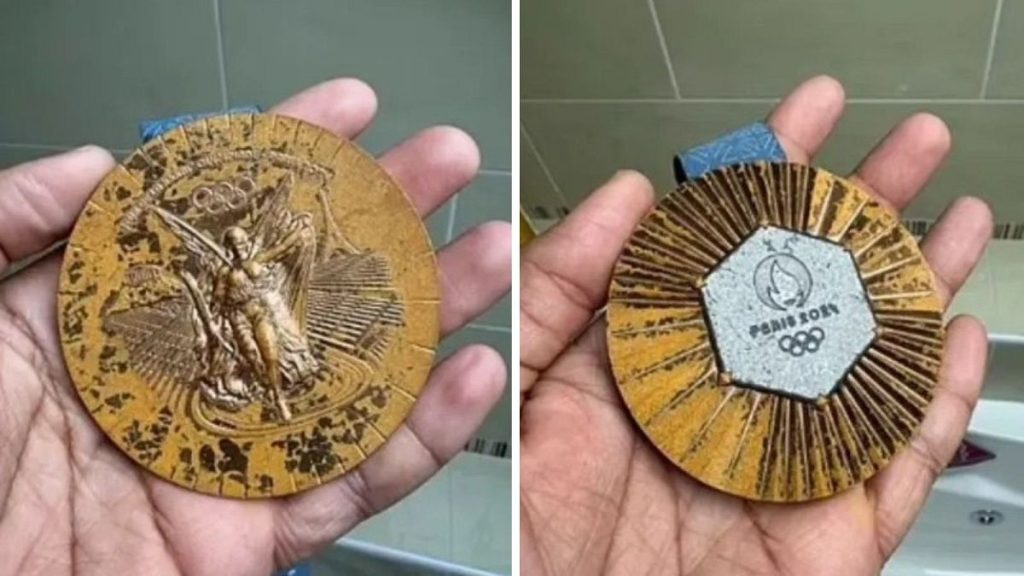The 2024 Paris Olympics, initially hailed as a resounding success, has been marred by a peculiar and embarrassing issue: the premature deterioration of the awarded medals. Over a hundred athletes have reported their medals crumbling, staining, and exhibiting surface wear, a stark contrast to the pristine condition of medals from previous games, particularly the Tokyo Olympics held just three years prior. This rapid decay has sparked widespread mockery, with some athletes humorously comparing their 2024 medals to relics from the 1924 Paris Games, the last time the city hosted the Olympics. The visible damage, primarily affecting the bronze medals, has become a public relations nightmare for the International Olympic Committee (IOC), who have issued an apology and promised replacements. This tarnishing of the symbols of athletic achievement casts a shadow over the legacy of the Paris Games and raises concerns about quality control and the long-term preservation of these cherished awards.
The root cause of this medal malady appears to be a faulty varnish. According to reports from French investigative outlet La Lettre, the original varnish planned for the medals contained chromium trioxide, a known carcinogen. The switch to an alternative varnish, ostensibly to avoid health risks, seems to have inadvertently introduced a different problem: accelerated degradation. The bronze medals, in particular, have borne the brunt of this issue, exhibiting significant weathering and discoloration. The IOC has acknowledged the problem and committed to replacing all affected medals, a process they assure will be completed by the first quarter of 2025. However, this timeline raises questions about the promptness of the response, given that athletes began reporting issues almost immediately after the Games concluded.
The responsibility for this medal mishap has become a subject of contention. Initially, much of the blame fell on Monnaie de Paris, the French mint responsible for producing the medals. However, Chaumet, the LVMH-owned design house behind the medals, has denied any culpability, emphasizing their role was solely in design, not production. This deflection of responsibility back to Monnaie de Paris highlights the complexities of multi-party collaborations and the potential for ambiguity when issues arise. While Monnaie de Paris has accepted the task of replacing the damaged medals, they have contested the IOC’s use of the term “defective,” preferring “damaged,” suggesting a difference in opinion regarding the fundamental nature of the problem.
The timeline of the medal degradation and the subsequent response reveals a concerning lag between the initial reports and the public acknowledgment of the issue. Athletes, including French swimmers and a British diver, observed the rapid deterioration of their medals even before leaving Paris. Australian cyclist Natalya Diehm’s bronze medal showed visible wear and tear after just a week. These early signs suggest that the problem was apparent almost immediately following the Games, yet it took several months for the issue to gain significant traction and for the IOC to initiate a formal replacement process. This delay raises questions about the IOC’s responsiveness and whether a more proactive approach could have mitigated the negative publicity.
The tarnished medals represent not just a material defect but a symbolic one. For athletes, Olympic medals embody years of dedication, sacrifice, and the pinnacle of athletic achievement. They are cherished keepsakes, tangible reminders of their triumph on the world stage. The degradation of these symbols diminishes the honor they represent and undermines the athletes’ pride in their accomplishments. The IOC faces the formidable challenge of not only replacing the physical medals but also restoring the tarnished image of the Paris Games and reaffirming the value and prestige of Olympic achievement.
The unfolding medal debacle presents several crucial lessons for future Olympic Games. It underscores the importance of rigorous quality control throughout the entire production process, from design to material selection to manufacturing. The incident also highlights the need for clear communication and accountability among all parties involved, including designers, manufacturers, and organizing committees. Finally, the delayed response to initial athlete complaints emphasizes the importance of proactive problem-solving and timely communication to prevent reputational damage and maintain the integrity of the Olympic spirit. The hope is that this incident will lead to improved practices and ensure that future Olympic medals stand the test of time, both physically and symbolically.














